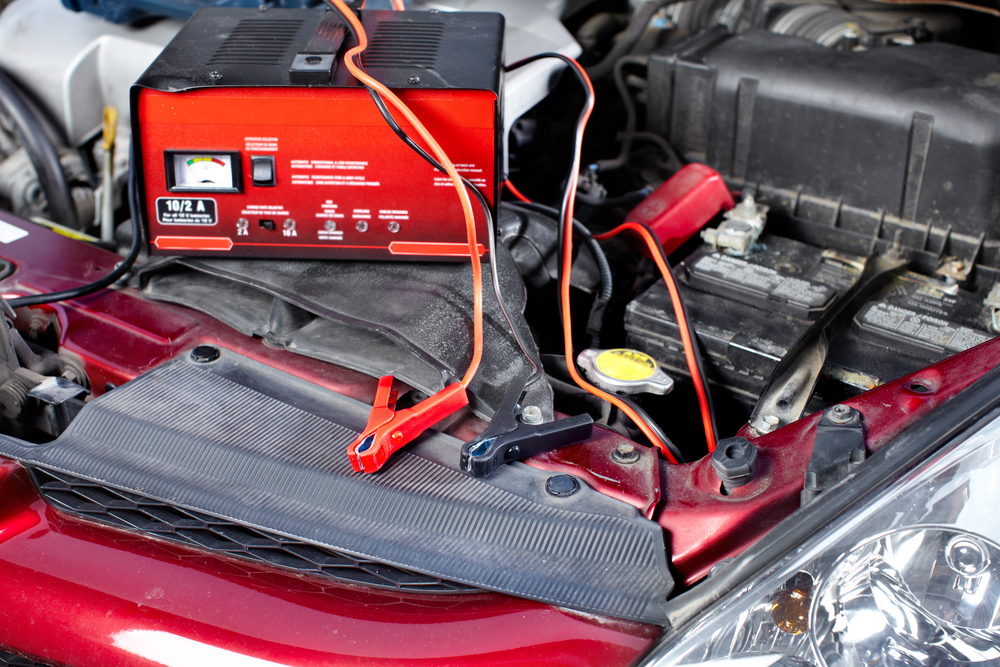Where would we be without batteries? We don’t often give them a second thought, but as many of us know, a flat battery can ruin your day. Whether you’re mowing your lawn or driving somewhere important, having a fully charged and properly working battery is crucial.
In this article, we’ll be looking at the most important things when it comes to picking a good battery charger. We’ve also come up with a list of the top 10 battery chargers out there today, so you can easily choose the right one for your needs.
- Choosing the Right Battery Charger
- Top 10 Best Battery Chargers 2023
- 1. Best Overall Charger: Schumacher SC1280
- 2. Best Premium Charger: NOCO GENIUS10
- 3. Best Budget Charger: Battery Tender® Junior 750mA
- 4. Best Charger for Battery Health: CTEK MXS 5.0
- 5. Best Multi-Device Charger: Battery Tender 4-Bank Battery Charger
- 6. Best Diagnostic Charger: Optima Digital 400
- 7. Best Solar-Powered Charger: Sunway Solar Panel Charger & Maintainer
- 8. BLACK+DECKER BC15BD
- 9. MOTOPOWER MP00207
- 10. Best Car Jump Starter/Battery Charger Combo: DBPOWER Portable Car Jump Starter
- What You Need to Know About Battery Chargers
- Final Thoughts
Choosing the Right Battery Charger
When it comes to battery chargers, choosing the right one can be a difficult task. To make your life easier, we’ve come up with a short guide on how to choose the best battery charger for your situation. We’ll briefly look at the different types of chargers out there, as well as the key things you should consider in a battery charger.
Types of Battery Chargers
The first thing you should know is that there are three main types of battery chargers. While they all supply power to batteries, they each work differently and result in different outcomes. Some chargers will only do one thing, whereas others like the NOCO GENIUS10 do everything, as they’re a combination of all three types.
Charger
This is your standard battery charger. It charges your battery at a constant rate until it’s fully charged, at which point you’ll need to disconnect it. Some intelligent chargers, like this one from MOTOPOWER, automatically cut the power once they’ve finished charging.
Maintainer
A battery maintainer provides a smaller amount of current at a steady rate to keep the battery topped up, and it only starts to charge once the voltage drops below a certain level. This means you can leave the battery connected for extended periods of time, which is perfect when storing batteries over the cold winter months.
Restorer
A battery restorer, also known as a desulfator, will restore the condition of your battery, making it more efficient and longer lasting. This saves you money, as you can squeeze more life out of an old battery before shelling out on a replacement. Restorers achieve this by breaking down and dissolving contaminants (usually sulfur) within the battery.
Crucial Things to Consider in a Battery Charger
In addition to choosing the right type of charger, you’ll need to make sure the battery charger works with your specific battery. The following points are crucial to keep in mind when choosing a battery charger.
Compatibility
Some battery chargers aren’t compatible with certain types of batteries. This is because there are many types of batteries that use different chemistries. In addition to that, the battery charger must match your battery’s voltage for it to work correctly.
Voltage
When it comes to voltage, you’ll find 6V, 12V, and 24V batteries. The most common is 12V, seen in a wide variety of vehicles. 6V batteries are sometimes used in small vehicles, whereas 24V batteries are rare and only used in heavy equipment.
In order for a battery charger to work with a battery, the voltage must be equal. That means a 12V battery will require a 12V charger. A 6V battery and a 12V battery won’t be able to be charged with the same charger, unless something like the NOCO GENIUS10 that works with multiple voltages.
Charging Power
If you have a large capacity battery, or if you want to charge your battery quickly, you’ll need to pick a charger with a high amp output. It’s no good trying to charge a large truck battery with a low amp charger; it’ll take too long. On the flip side, if you’re just looking to keep your batteries topped up, a charger with a low amp output will suffice. We go into more detail about amps in our full guide.
Safety Features
Batteries can be dangerous, especially when they’re being charged. Most good battery chargers will incorporate several safety features designed to protect both you and your battery from damage. It’s worth spending a little bit extra on a battery charger that has multiple safety features, for your own peace of mind at the very least.
Ease of Use
If you’ve never used a battery charger before, you’ll want the process to be as hassle-free as possible. Thankfully most of the chargers out there are easy to use as they operate automatically. In most instances, you just connect the battery, switch the charger on, and let it do its thing. In some situations, there may be additional steps or manual intervention required.
We’ve kept all of these crucial points in mind when choosing the top 10 battery chargers for our list. The most important information has been highlighted so you can easily see which charger best fits your needs.
Top 10 Best Battery Chargers 2023
1. Best Overall Charger: Schumacher SC1280
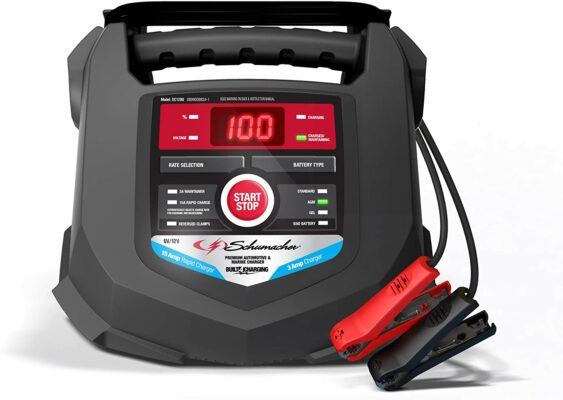
Editor’s Rating:
At a Glance:
- Type: Charger and maintainer
- Amperage: 15A for rapid charging and 3A for maintaining
- Voltage: 6V and 12V
- Compatibility: Lead-acid (AGM, gel, deep-cycle) batteries
Standout Features
This battery charger outputs 15A for rapid charging and 3A for maintaining batteries. Whether you need to get your battery juiced up fast or simply want to trickle charge, the SC1280 will adequately do both.
The reverse polarity protection will prevent the charger from operating if the clamps are reversed, saving you from killing the battery. It’s also one of the only chargers that meets industry standards when it comes to energy efficiency.
Its user-friendly design features LED indicators and a digital display. These show the battery type, charging rate, voltage, and charging status in a way that’s easy to understand, although the digital display can sometimes be glitchy. Once you’ve connected the battery, the LED indicators will tell you if the battery is faulty. That’ll save you time trying to charge a completely dud battery.
Our Thoughts
The Schumacher SC1280 is our best overall pick for several reasons. It’s a mid-priced charger that’s perfect for people who have never used a battery charger before. The simple design and automatic operation make it a quality charger that will suit most people’s needs.
The SC1280 is designed to charge and maintain medium-sized batteries, such as those found in motorcycles, lawnmowers, cars, and SUVs. While it can maintain RV and truck batteries, it won’t be able to charge them if they’re completely dead. If you do need to charge dead batteries, the GENIUS10 will be more suitable for you.
Our only issue with this battery charger is that the build quality could be better.
Pros
- 15A output charges batteries fast
- Fully automatic operation
- Meets industry standards in energy efficiency
- Reverse polarity protection
- Easy to understand LED indicators and digital display
Cons
- Build quality could be better
- Display is sometimes glitchy
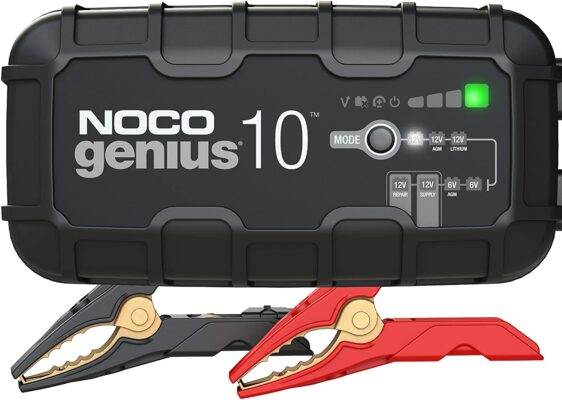
Editor’s Rating:
At a Glance:
- Type: Charger, maintainer, and restorer
- Amperage: 10A
- Voltage: 6V and 12V
- Compatibility: Lead-acid (AGM, gel, deep-cycle) and lithium-ion batteries
Standout Features
The GENIUS10 will automatically charge severely depleted batteries as low as 1V. It can even charge batteries with 0V when using the manual force mode. This makes it an ideal charger for bringing even the most depleted batteries back to life.
There are plenty of safety features to protect both the battery and yourself, including reverse polarity protection, short circuit protection, overheating prevention, and open-circuit protection. An integrated thermal sensor keeps an eye on the ambient temperature to prevent the risk of over and undercharging.
The spark-proof clamps have also been redesigned and improved upon from the previous generation. They now have a higher clamping force and improved conductivity, making them more efficient and easier to connect.
Our Thoughts
The NOCO GENIUS10 is aptly named as it’s one of the most advanced chargers on the market. It’s the latest and most versatile charger by NOCO, offering 115% more charging power in a 17% smaller device than the previous generation model. While it is more expensive than some of the other chargers, NOCO is a brand with an excellent reputation, and their customer support is second to none.
This charger has some seriously impressive capabilities and features, which is reflected in the premium price. The only thing we don’t like is the fact that it uses a proprietary cord connection that can’t be removed. You’ll need to purchase a separate adapter if you plan on using an SAE cable.
Pros
- Works as a charger, maintainer, and restorer
- Charges batteries as low as 1V automatically and 0V manually
- Smaller and more powerful than the previous generation
- Excellent brand with fantastic customer support
- Advanced safety features
Cons
- Requires separate adapter for SAE cables
3. Best Budget Charger: Battery Tender® Junior 750mA
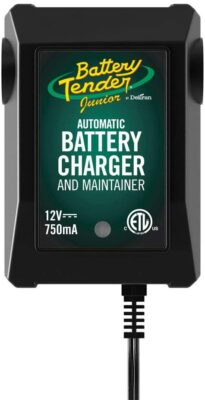
Editor’s Rating:
At a Glance:
- Type: Charger and maintainer
- Amperage: 0.75A
- Voltage: 12V
- Compatibility: Lead-acid (AGM and gel) batteries
Standout Features
The 4-step charging system prevents overcharging and optimizes battery power. It also has a spark-proof lead, ISM adaptive charging, and it automatically detects reverse polarity. The ISM adaptive charging will resume full power output if the battery voltage drops too low under load, ensuring the battery charges safely.
Our Thoughts
The Battery Tender® Junior 750mA is one of the smallest and cheapest chargers on our list, making it an excellent budget option for people looking to charge and top up small batteries. At just 0.75A it won’t be the fastest charger, but it wasn’t designed for speed, unlike this 15A Black+Decker charger. It was designed for charging and maintaining small to medium-sized batteries kept in storage, and it does that perfectly well.
The Battery Tender® Junior 750mAis best suited for charging and maintaining devices and machines with smaller lead-acid batteries, such as scooters, ATVs, motorcycles, and lawnmowers. It won’t charge dead car and SUV batteries, but it can maintain them. A small 15Ah battery will take around 20 hours to fully charge with this device.
Pros
- Lightweight and compact
- Charges and maintains small capacity batteries
- 4-step charging program for optimal charging
Cons
- Low 0.75A output is slow to charge
4. Best Charger for Battery Health: CTEK MXS 5.0
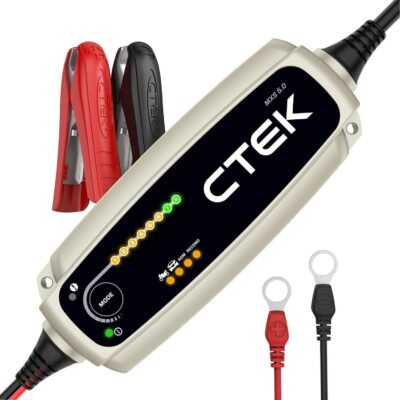
Editor’s Rating:
At a Glance:
- Type: Charger, maintainer, and restorer
- Amperage: 4.3A
- Voltage: 12V
- Compatibility: Lead-acid batteries
Standout Features
This charger by CTEK has an 8-step charging system that restores, charges, and maintains your battery without any manual input; it’s entirely automatic. You can essentially hook your battery up and leave it to charge as the advanced onboard microprocessor monitors everything from temperature to charge status.
The unit itself is very compact and sealed for extra protection. It also features short circuit protection, reverse polarity protection, and the clamps are also spark-proof.
Some battery chargers come with garbage cables, however that’s not the case here. The CTEK MXS 5.0 comes with high-quality cables, although we must point out that the plastic clamps are brittle. It also comes with eyelets, making it easier to connect to batteries located in tight spaces.
Our Thoughts
The MXS 5.0 is ideal for reconditioning, charging, and maintaining batteries in a variety of vehicles and hardware, including jet skis, motorcycles, cars, tractors, lawnmowers, boats, and SUVs. It’ll happily charge large batteries up to 100Ah capacity and maintain batteries up to 160Ah.
The battery will need to have at least 2V for this charger to work, making it unsuitable for completely dead batteries. If you need something that charges dead batteries, take a peek at the NOCO GENIUS10 – it can charge batteries as low as 0V.
All in all, this is a good charger that does more than just charging for a reasonable price. It’s a little cheaper than our premium pick, but it’s slightly more expensive than the mid-range products.
Pros
- 8-step charging system restores, charges, and maintains
- High quality charging cables
- Compact unit is sealed for protection
- Charges large batteries up to 110Ah
Cons
- Can’t charge batteries under 2V
- Plastic clamps are brittle
5. Best Multi-Device Charger: Battery Tender 4-Bank Battery Charger
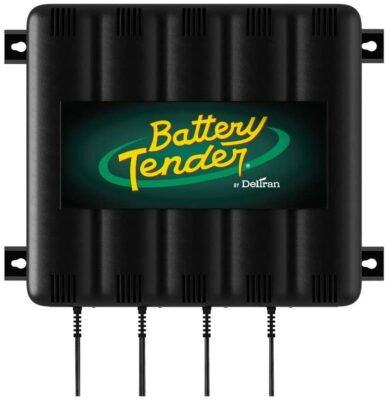
Editor’s Rating:
At a Glance:
- Type: Charger and maintainer
- Amperage: 1.25A per station
- Voltage: 6V and 12V
- Compatibility: Lead-acid (AGM, flooded, and sealed) batteries
Standout Features
The four charging banks allow you to charge four batteries simultaneously, each receiving 1.25A. This makes it an ideal battery charger and maintainer for batteries kept in storage, especially if you have multiple vehicles that need to be kept topped up.
The 72-hour safety timer cutoff ensures that the batteries don’t get overcharged, and the reverse polarity protection protects batteries from damage. The clamps are also spark-proof.
Our Thoughts
This product is similar to the Tender Junior, but it has a higher output and four individual stations for charging. While it will charge smaller batteries, it’s best suited for maintaining boat, truck, car, and SUV batteries. It can charge larger batteries, but the process will take longer than something like the faster Schumacher SC1280. In addition to that, the Battery Tender 4-Bank is not capable of charging dead batteries.
The standard leads are a little short, but there is an option to purchase 25ft extension leads. It’s not as good as our premium pick despite it costing more, but you are paying for the convenience of having four charging stations in one compact device.
Pros
- Four charging stations
- 72-hour safety timer cutoff
- Option to purchase longer 25ft leads
Cons
- Expensive for what it is
- Won’t charge dead batteries
6. Best Diagnostic Charger: Optima Digital 400
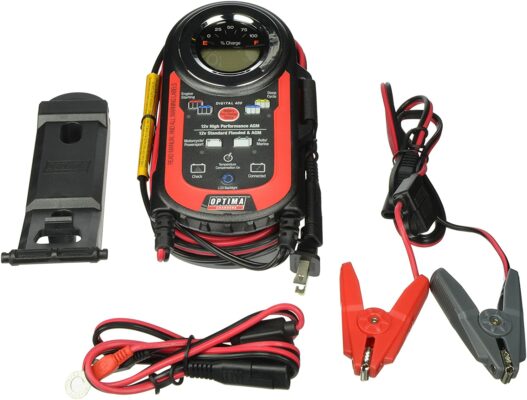
Editor’s Rating:
At a Glance:
- Type: Charger, maintainer, and restorer
- Amperage: 4A
- Voltage: 12V
- Compatibility: Lead-acid (AGM, flooded) batteries
Standout Features
Deeply discharged batteries can be easily recharged with the Optima 400 Digital. Its intelligent microprocessor helps provide faster and more efficient charging that helps extend and maintain battery life. It also increases battery performance as it breaks up sulfation within the battery.
It’s fully automatic and capable of diagnosing a variety of battery faults, which helps avoid overcharging and alerts you to major issues with the battery. There’s also a reverse polarity warning built-in, and the device has anti-spark protection.
Our Thoughts
Optima are known for their powerful batteries, and although this device is primarily aimed for use with Optima batteries, it does work with other brands. Its hybrid LED gauge and LCD display make it easy to understand how the charging process is progressing.
The case isn’t the best quality, with some of the plastic parts being a bit brittle. While it does work with most lead-acid batteries, it isn’t compatible with gel batteries. If you need a charger with a similar output that works with gel batteries, take a look at the MOTOPOWER MP00207.
Pros
- Restores deeply discharged batteries
- Diagnoses battery faults and failures
- Trusted brand known for high-quality products
Cons
- Not compatible with gel batteries
- Plastic parts are brittle
7. Best Solar-Powered Charger: Sunway Solar Panel Charger & Maintainer
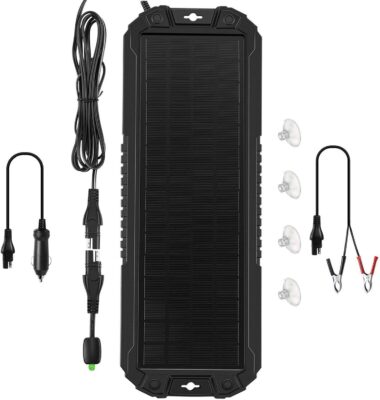
Editor’s Rating:
At a Glance
- Type: Solar-powered charger and maintainer
- Amperage: Not provided by manufacturer
- Voltage: 12V
- Compatibility: Lead-acid (wet, gel, AGM, deep-cycle) batteries
Standout Features
Unlike the rest of the products on our list, this is a solar-powered charger. We may be stating the obvious here, but it uses sunlight to charge batteries. This makes it an excellent option for use in the outdoors or for camping, especially as it’s so lightweight and portable. The caveat is that you’ll need to be somewhere where there’s plenty of sunlight for it to work.
The construction uses monocrystalline solar cells, which are of higher quality and more efficient than other types of solar cells. The tempered glass protects the device from snow, water, and dust. It uses ABS plastic in its construction, which is a lot stronger and more durable than other types of plastic.
Our Thoughts
Solar-powered battery chargers aren’t as good power-wise as their mains electric counterparts, but that doesn’t mean this product should be dismissed. It has a rightful place in the world of chargers, especially when using it in places where there isn’t a power outlet.
While the Sunway solar power charger won’t restore or charge dead batteries, it will trickle charge and maintain batteries over longer periods of time. It’s sufficient for keeping car, truck, motorcycle, ATV, RV, and boat batteries topped up.
It comes with a cigarette lighter adapter and battery terminal clamps, so it can be connected directly to the battery or the vehicle’s 12V socket. The included suction cups are a nice addition, allowing you to mount the charger to the windshield for maximum sunlight exposure and protection.
Unfortunately there’s no reverse polarity protection, so be careful when hooking it up to a battery. The amperage isn’t provided by the manufacturer, but for batteries over 50Ah there’s no risk of overcharging. For batteries under 50Ah, you’ll need to purchase a solar charge controller to avoid the risk of overcharging.
Pros
- Super lightweight at just 1.5 pounds
- High-quality material used in the solar cells
- Great for using outdoors where there’s no power outlet
- Durable ABS plastic protects the unit
Cons
- No reverse polarity protection
- May require a separate charge controller
- Amperage info not provided
8. BLACK+DECKER BC15BD
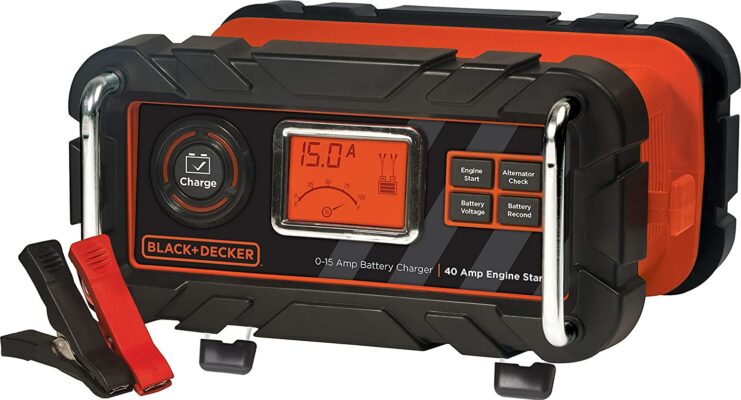
Editor’s Rating:
At a Glance:
- Type: Charger, maintainer, and jump starter
- Amperage: 15A maximum charging output and 40A peak output
- Voltage: 12V
- Compatibility: Lead-acid (AGM, gel, wet) batteries
Standout Features
The Black+Decker BC15BD offers drivers several unique features that make dealing with dead batteries no hassle at all. There’s nothing worse than getting in your car for work to find the engine won’t start. If that’s down to a flat battery, this charger will have you up and running in under 2 minutes thanks to its 40A engine start feature.
In addition to that, it can also diagnose faulty alternators. The alternator charges the battery as you drive, and a faulty alternator can leave the battery drained. There’s no need to second guess whether your alternator is dead, as this B+D device will let you know.
As with many battery chargers, the BC15BD has reverse polarity protection to avoid damage to the battery. It also shuts off automatically once the battery is fully charged.
Our Thoughts
Black+Decker are well known for their excellent power tools and hardware, and this device lives up to that reputation. In addition to quickly charging flat batteries, it also doubles as a jump starter and alternator diagnostic tool.
Charging is fully automatic, and the simple LCD screen displays the charging and battery status. Unfortunately, charging completely dead batteries is a bit hit and miss, so if your battery is as dead as a dodo, the MOTOPOWER will be a better choice.
For the price and unique features it offers, you can’t go wrong. That is unless you’re using it outside in bad weather – it isn’t weatherproof, unlike its slightly less powerful sister product.
Its compact size makes it ideal for carrying around in your vehicle, in case you get caught out (although you will need access to a power outlet to jump-start as it doesn’t have an onboard battery, unlike the DBPOWER Portable Jump Starter).
Pros
- Quickly jump starts flat batteries
- Fast 15A charging output
- Diagnoses faulty alternators
Cons
- Not good at charging dead batteries
- Requires an outlet to jump-start vehicles
9. MOTOPOWER MP00207
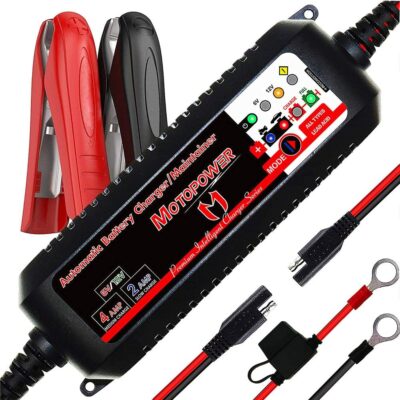
Editor’s Rating:
At a Glance
- Type: Charger, maintainer, and restorer
- Amperage: 4A and 2A
- Voltage: 6V and 12V
- Compatibility: Lead-acid (AGM, gel, flooded, maintenance-free) batteries
Standout Features
This device by MOTOPOWER automatically detects the battery voltage once connected, and it’ll warn you if the battery is dead. If the battery isn’t completely dead but severely depleted (under 1V), there is a manual mode to force charge the battery. This is useful, as it may save you from throwing out a perfectly salvageable battery.
The onboard microprocessor will monitor charging progress and cut off the power once the battery is fully charged, which prevents overcharging. It also features short-circuit protection, reverse polarity protection, and uses spark-free technology with the included terminal clamps.
Our Thoughts
MOTOPOWER isn’t a well-known brand and it feels pretty cheap, perhaps because it is cheap. Considering its premium features and its low price point, we think it’s a good option, although if you can stretch your budget we’d recommend opting for the premium GENUIS10, as it’s undoubtedly the higher quality product out of the two.
It comes with SAE quick disconnect terminal clamps which we like, as some other products require separate adaptors to use SAE leads. It offers a degree of weatherproofing, as it’s splashproof and dustproof, however it isn’t fully waterproof.
Pros
- Premium features at a low price
- Charges batteries under 1V
- Good value for money
Cons
- Obscure brand
- Unit feels cheaply made
10. Best Car Jump Starter/Battery Charger Combo: DBPOWER Portable Car Jump Starter
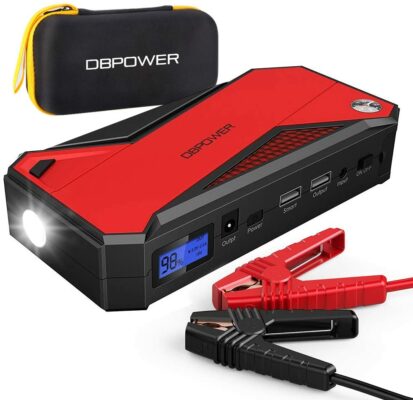
Editor’s Rating:
At a Glance:
- Type: Jump starter and power bank
- Amperage: 800A peak output
- Voltage: 12V
- Compatibility: Lead-acid and lithium-ion batteries
- 18,000mAh battery capacity
Standout Features
First and foremost, this isn’t a battery charger in the traditional sense. It’s a portable jump starter that doubles as a power bank. It can jump-start batteries with at least 50% charge thanks to its huge 800A peak output and 18,000mAh battery capacity. That’s enough power to jump-start 7.2L gas engines and 5.5L diesel engines 20 times on just one charge.
Because of its large battery capacity, it can be used to charge a variety of devices via USB, including smartphones, laptops, and more. It also comes with plenty of adapters to fit most products.
Our Thoughts
This portable jump starter is designed for vehicles that won’t start due to a semi depleted battery. Once the vehicle is running again, the alternator should take over and charge the battery. If your alternator is kaput, this device won’t be of much use. If you do suspect that your alternator is faulty, take a look at the B+D BC15BD, as it can diagnose alternator faults.
We believe that this is a good option for people who may be worried about their vehicle starting up, especially if their vehicle’s battery drains overnight. It’s also pretty handy to have a large capacity power bank available at any time to charge other devices, like smartphones and cameras. It’s the perfect device for taking with you when camping, or for storing in your vehicle in case of emergencies.
The only major downside is that the battery seems to only hold its charge for a week, so you’ll need to recharge it via the 12V car charger or 12V wall charger every so often.
Pros
- Portable jump starter gets vehicles running quickly
- Doubles as a power bank to charge devices via USB
- High capacity 18,000mAh battery
Cons
- Not a normal battery charger
- Internal battery doesn’t stay charged for long
What You Need to Know About Battery Chargers
Now that we’ve looked at some of the best battery chargers on the market, let’s take a more detailed look at the most important things when it comes to batteries and chargers.
Amperage
The amperage, or amps, determines how much current flows from the charger into the battery. To put it another way, the amp output determines how fast the battery charges. The higher the amps, the faster the battery charges.
As a rough guide, you can work out how long a battery will take to charge based on its capacity and the charger’s output. A typical 80Ah car battery will take roughly 8 hours to charge with a 10A battery charger. This isn’t 100% accurate, as other factors come into play, such as the battery’s health and the charging efficiency, but it’s a good rule of thumb.
If you have a large capacity battery, a lower amp charger will take a long time to charge it. Make sure you choose a battery charger with a high output. One such example is the 15A rapid charger from Schumacher.
Safety Features
Batteries can be dangerous, and charging them shouldn’t be taken lightly. They contain hazardous chemicals that can cause significant damage to you and your property if they’re charged incorrectly.
Most good battery chargers will include several safety features designed to protect the battery from exploding or releasing toxic gases. Even though it’s inexpensive, the MOTOPOWER MP00207 has a variety of advanced safety features that are on par with our premium pick. At a minimum, we’d recommend the following safety features.
Reverse Polarity
Batteries have a positive and negative terminal. When connecting a battery charger, the clamps must be connected to the terminals the right way around. If they’re connected the opposite way, the battery can become permanently damaged.
Reverse polarity protection will prevent the battery charger from operating if it detects that the polarity is reversed. Some chargers will also indicate this with a warning light.
Overcharge Protection
Overcharging can create high temperatures within the battery, which releases hydrogen and oxygen. In sealed batteries, this can cause the battery to explode. In addition to that, overcharging reduces a battery’s lifespan.
Overcharge protection will cut the power once it detects the battery is fully charged. If it’s a maintainer, it will monitor the battery’s voltage and only add more current as needed.
Spark-Proof Clamps
If you’ve ever connected jump leads to a car battery, you may have seen sparks fly. These sparks can cause explosions if the battery is releasing hydrogen gas, which is something you want to avoid.
Spark-proof clamps use materials that prevent sparks, eliminating the chance of an explosion occurring.
Additional Types of Battery Chargers
In our short guide, we quickly looked at the three main types of chargers. In addition to those three types, there are also many more subcategories of chargers. Below are some of the most common types, although many more types exist.
Intelligent Chargers
Intelligent chargers like the Optima 400 Digital use built-in microprocessors to monitor the battery’s voltage and temperature. With this information, the charger will detect when the battery reaches 80% capacity and switch it to trickle or float charging to maintain power.
Doing this is better for the battery, as slow charging towards the end of the charging cycle maintains long-term battery health.
Multi-Stage Chargers
Multi-stage chargers are a combination of the above, meaning they’ll switch between different charging modes depending on the battery’s status. Some have 3 or 4 stages, while others, like the CTEK MXS 5.0, have as many as 8. Some of these stages include desfulating the battery before charging, fast charging, and float charging. The different stages are designed to prolong battery life and increase efficiency.
Solar Powered Chargers
Most typical battery chargers require an outlet to work, transferring power from the mains to the battery. Solar-powered chargers use solar energy from the sun to charge batteries, so no outlet is needed. While they are a lot slower than standard chargers and are generally only used to trickle charge, they’re a convenient option for keeping your batteries going when there’s no power outlet available.
Trickle Chargers
Trickle chargers are low-amp chargers designed to top up drained batteries over longer periods of time. They’re great if you’re not in a rush to charge your battery, as slower charging is better for the battery’s health than fast charging. Once the battery is fully charged, trickle chargers will automatically shut off to prevent overcharging.
Some battery chargers, including Schumacher SC1280 our top overall pick, include trickle functions on top of their full-power charging.
Float Chargers
Float chargers are similar to trickle chargers, however they won’t charge dead batteries, so we haven’t included any on this list (though those who need one should be satisfied by this model from Cen-Tech). They’re designed to be maintainers, providing just enough power to keep the battery fully charged, so long as it isn’t completely dead in the first place.
Float chargers are best for batteries kept in storage, as they can be used regularly and left without supervision with no risk of overcharging.
Most Common Types of Batteries
Lead-acid batteries and lithium-ion batteries are the most common types of batteries used today. The former is generally used in vehicles, as the chemistry is a lot safer, while the latter is used for small devices as they have a higher capacity for their size.
The most important thing is to know what type of batteries you’ll want to charge, and to choose a charger that can handle them.
Lead-Acid Batteries
There are several types of lead-acid batteries on the market. While they may look the same, they’re all designed slightly differently, giving them different characteristics. Because of this, not all lead-acid battery chargers will work with every type of lead-acid battery.
Flooded (Wet)
Flooded batteries, also known as wet batteries, contain an electrolyte that is free to move around inside the battery. The battery acid and lead plates store the electricity when the battery is fully charged. These batteries are designed to be mounted upright to ensure that the electrolyte doesn’t leak out from the top.
These are the most economical batteries as they’re cheap for the capacity they hold, however they do require more maintenance, such as topping up the water level. The other downside to these batteries is that they can release toxic hydrogen gas when charging.
Sealed
Sealed batteries are similar to flooded, but the electrolyte is sealed inside, so it can’t be changed. This means they have a definitive life span, but they don’t require any maintenance. Because of this, they can be mounted in different ways as there’s no risk of the electrolyte leaking. Not all sealed batteries are the same, as we’ll see below.
AGM (Sealed)
AGM or absorbent glass mat batteries are the most popular type of battery, as they work in a wide variety of conditions. The electrolyte is suspended in a thin fiberglass mat between the lead plates, making the battery resistant to vibrations. They can be mounted in any orientation, and they’re often seen on their sides. This makes them ideal for use in RVs and other large vehicles.
While they are more expensive than flooded batteries and not as long-lasting, there is no maintenance required and there’s a much smaller risk of toxic gas building up while charging. They are often found in golf carts, mobility vehicles, and large vehicles such as cars and trucks.
Gel (Sealed)
Gel batteries are similar to AGM batteries, but instead of fiberglass mat, they use a thick paste. The most significant difference between the two is the charge rate. AGM batteries can charge and discharge at higher rates than gel, however gel batteries can last longer in hot climates.
Deep-Cycle
Deep-cycle batteries provide a long, consistent stream of power over an extended period of time. They’re designed to be regularly charged and discharged, so you’ll find them in golf carts, electric vehicles, and power tools like floor scrubbers.
Lithium-Ion Batteries
Lithium-ion batteries are used in modern technology, in things like laptops, smartphones, and cameras. They have the best capacity to weight ratio, making them ideal for smaller devices. They’re not used in vehicles that use fossil fuels, as the chemistry is a lot more volatile than lead-acid batteries, and punctures can cause insane explosions.
Having said that, you will find lithium-ion batteries in modern electric vehicles, but their limits are being pushed to the maximum. These batteries are also used in power tools, although they usually require a specific charger only supplied by the manufacturer.
While there are different types of lithium-ion batteries, that’s out of the scope of this article. If you’re interested in learning more about lithium-ion batteries, take a look at this useful guide.
Final Thoughts
By now you should have a better understanding of batteries and battery chargers. As we’ve seen, not all chargers are the same, so it’s important to pick one that does what you need it to do. The most important thing, of course, is to make sure that it’s compatible with your battery.
No matter whether you want to charge a car battery or a lawnmower, or maintain your motorcycle battery over the winter, there’s a battery charger to suit every type of battery and situation.

